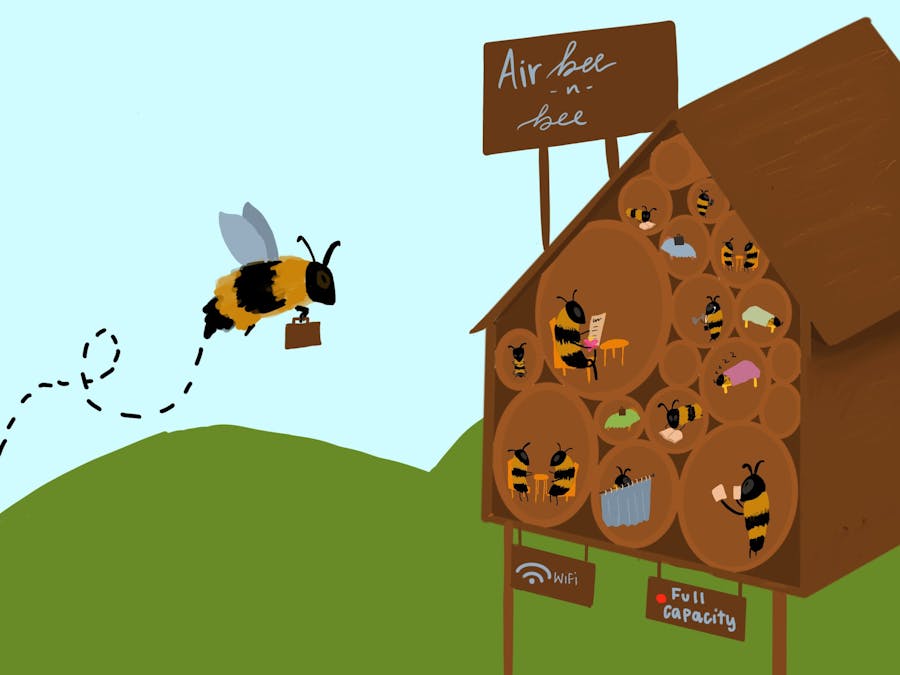Honey bees get a lot of attention, but they are only one of thousands of species of bees in North America (and they are not even native!).
Native bees co-evolved with native plants and their pollination services are essential to the survival of many native plant species.
Native bees are also important agricultural pollinators and improve the yields of many agricultural crops. AirBeeNBee is a smart bee hotel that provides nesting habitat for native bee populations, directly addressing contestChallenge 5: precision farming, smart animal husbandry, and local food production.
Solitary native bees start their families in all different kinds of nests. Some bees make nests the ground (digger bees, miner bees), some bore holes into wood (carpenter bees), and others lay eggs in hollow tubular plant stems (mason bees, leafcutter bees). A few of these species will use artificial nest structures provided by humans (bee hotels), which gives us an awesome opportunity to study them.
DesignThe AirBeeNBee is a bee hotel with integrated sensors that allows hosts to investigate all kind of variables that might be affecting whether a bee chooses their artificial nest. The nest can be filled with different materials to evaluate nesting preferences, and the Seed Studio SenseCap K1100 allows us to easily determine how humidity, temperature, and air quality affect nest utilization. The AI vision sensor allows quick determination of bee species and percent occupancy. Because the plans are all open source using commonly available equipment in maker spaces - AirBeeNBee meets contest Challenge 4: Open Science.
Our bee hotel is designed to monitor bees without the destructive and labor-intensive methods that are currently used. We will monitor the native bee populations in artificial nests using a camera, with the goal of not only tracking how many bees are going in and out of the AirBeeNBee, but also seeing what happens inside the nests.
The structure is a house with a sloped roof, to keep the house dry and provide a space to attach the camera. We learned that having mesh in front of artificial nests does not deter bees from using them, so having the camera should not be a problem for the bees. The material used will be wood to prevent rot and mold growth in the nest.
Inside the house, we will insert removable wooden blocks, drilled with bee tunnels. These tunnels will go all the way through the blocks, to allow for observation of the bees and their nests if necessary. The tunnels will be a variety of sizes to accommodate different species of bees. They should be at least 15 centimeters long and between 3-10 millimeters in diameter, according to the Bumblebee Conservation Trust.
The technology behind the bee hotel is the SenseCAP K1100 Sensor device. This device is primarily used with built-in sensors (light, sound, and position) and attachable sensors (soil moisture, temperature/humidity, gas sensor, and vision) along with a screen, or terminal, to view readings, logs from vision detection, and to send data over a network to an online data visualization platform for further analysis.
To use the SenseCAP device, we followed the setup instructions here (https://wiki.seeedstudio.com/K1100-quickstart/#vision-ai-real-time-analysis). After setting up the SenseCAP using LoRa WAN to transmit data, we were ready to begin setting it up to monitor the bees!
To monitor the bees, we use the Grove AI Vision Sensor that came with the Seeed Studio Starter Kit. We plugged in the camera into the terminal and configured it to work with the terminal. The camera currently only detects people, so we had to retrain the model that backs the Grove AI Vision Sensor to detect bees (more information about this under Code). In short, we captured several hundred images of bees, labeled the images to show where the bees were in the photos, and used this labeled dataset to retrain the Grove AI Vision Sensor model.
The TeamThe team that developed this project are undergraduate students on the Living Building ScienceVertically Integrated Projects Team at Georgia Tech in Atlanta, GA. They collaborated with the Georgia Tech Urban Honey Bee Project to identify a project that would allow them to apply their expertise in computer science toward an important sustainability challenge: protecting pollinators.
Innovation and the Future of Air BeeNBeeAir BeeNBee is a consumer-friendly participatory science project that will allow anyone to observe and learn about pollinators in their environment. By harnessing the power of computer vision models, users can not only learn about which pollinators are nearby, but can predict how changes in environmental conditions will influence their numbers. For the future of this project, we are planning on using the Grove AI Vision Sensor to detect bees in our bee hotel to monitor bee populations around our city. We are also planning on connecting our Seeed Studio Kit to Microsoft Azure IoT Central to visualize the data. Using Microsoft Azure will allow us to harness the powerful analytics and integration tools that come with this technology as well as solve any storage solutions that we run into in the future. Using a cloud technology will not only make the data analysis of Air BeeNBee faster, more efficient, and more controlled, but it will also be incredibly accessible and scalable as the project grows. The more people who "open" Air BeeNBees around the world, the more we can know and understand about how to protect pollinators and our food supply.
*cover image by Savanna Panackal










Comments
Please log in or sign up to comment.